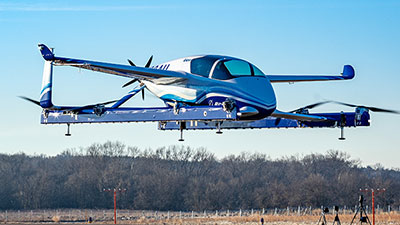You may find it strange to travel in an autonomous vehicle, but what about flying in an autonomous aircraft? Boeing has successfully completed the first test flight of its autonomous passenger air vehicle (PAV) prototype. The flight took place at an airport outside of Washington, D.C. While the plane hovered in the air for less than 60 seconds and no one was on board, it’s still an engineering feat.
Boeing’s NeXt division is developing autonomous airplanes—also known as air taxis or flying cars. The company has teamed up with Aurora Flight Sciences to design the electric vertical takeoff and landing (eVTOL) aircraft. One purpose for the vehicle is to minimize traffic congestion in urban areas.
The PAV prototype, which is 30 feet long and 28 feet wide, was able to takeoff, hover, and land without problems. Developers conducted the experiment to test the aircraft’s autonomous functions and ground control systems. Further tests will involve forward, wing-borne flight and transitioning between vertical and forward-flight modes, which is “typically the most significant engineering challenge for any high-speed VTOL aircraft,” according to Aurora Flight Sciences.
It took Boeing just one year to turn a concept into a prototype, according to Boeing Chief Technology Officer Greg Hyslop.
“Boeing’s expertise and innovation have been critical in developing aviation as the world’s safest and most efficient form of transportation, and we will continue to lead with a safe, innovative and responsible approach to new mobility solutions,” he commented.
The PAV prototype is powered by an electric propulsion system. It has a range of up to 50 miles. The aircraft’s advanced airframe combines the propulsion and wing system to enable hovering and forward flight.
“This is what revolution looks like, and it’s because of autonomy,” said John Langford, president and chief executive officer of Aurora Flight Sciences. “Certifiable autonomy is going to make quiet, clean and safe urban air mobility possible.”
Boeing NeXt is striving to create a future where “autonomous and piloted air vehicles safely coexist.” The company has already developed an autonomous electric cargo air vehicle (CAV) that successfully completed its first indoor flight in 2018. Outdoor flight testing will commence later this year.
“Boeing was there when the aviation industry was born and in our second century, we will unlock the potential of the urban air mobility market,” said Steve Nordlund, vice president and general manager of Boeing NeXt. “From building air vehicles to airspace integration, we will usher in a future of safe, low-stress mobility in cities and regions around the world.”
Eric Bartsch, chief operating officer at VerdeGo Aero, which develops the power systems for eVTOL, told CNN that as many as 10 companies have also performed autonomous flights.
Meanwhile, Aura Flight Sciences has partnered with Uber, which plans on launching air taxis in the commercial space by 2023. Boeing estimates its eVTOL won’t hit the skies until the early 2020s.


